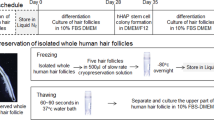Abstract
Human melanocyte stem cells (MSCs) or melanoblasts are not well-investigated owing to the devoid of suitable culture system. Establishing cell lines of MSCs and/or their progenies from human hair follicles will provide a better opportunity to satisfy clinical needs and to enable a deeper understanding of hair-related diseases. In the present study, we cultured melanocytes derived from human fetal hair follicles, perform immunocytochemistry and Fontana Masson staining on them, and employed atomic force microscopy (AFM) and scanning electron microscopy to observe their subtle morphologies. The results show that the cultured melanocytes have a bipolar or tripolar appearance, which obviously differ from cultured epidermal melanocytes. Compared to cells derived from adult human hair follicles, these cells display a high proliferative capability and exhibit a clonal growth behavior. At the second passage, all these cells were positive for immunocytochemical staining with the NKI/beteb monoclonal antibody and Fontana Masson staining. Under AFM, the cells exhibited rounded, oval, triangular, or quadrangular perikarya, from which two or three dendrites arose. The dendritic arbor was not homogeneous but appeared as spindle-shaped dendritic swellings, knob-like processes, without any filopodia arising from the dendrites or the cell body. Without using a feeder layer, we successfully obtained the clonal growth of melanocytes from human fetal HFs, suggesting that the medium was suitable for the growth of MSCs and their progenies.






Similar content being viewed by others
References
Aubin-Houzelstein G.; Djian-Zaouche J.; Panthier J. J. Melanocyte stem cells in adults. J. Soc. Biol. 202: 25–32; 2008.
Buac K.; Pavan W. J. Stem cells of the melanocyte lineage. Cancer Biomark. 3: 203–209; 2007.
Cui J.; Shen L. Y.; Wang G. C. Role of hair follicles in the repigmentation of vitiligo. J. Invest. Dermatol. 97: 410–416; 1991.
Hirobe T.; Furuya R.; Akiu S.; Ifuku O.; Fukuda M. Keratinocytes control the proliferation and differentiation of cultured epidermal melanocytes from ultraviolet radiation B-induced pigmented spots in the dorsal skin of hairless mice. Pigment Cell Res. 15: 391–399; 2002.
Hsu M. Y.; Li L.; Herlyn M. Cultivation of normal human epidermal melanocytes in the absence of phorbol esters. Methods Mol. Med. 107: 13–28; 2005.
Hsu Y. C.; Pasolia H. A.; Fuchs E. Dynamics between stem cells, niche, and progeny in the hair follicle. Cell 144: 92–105; 2011.
Imokawa G.; Yad Y.; Morisaki N.; Kimura M. Biological characterization of human fibroblast-derived mitogenic factors for human melanocytes. Biochem. J. 330: 1235–1239; 1998.
Lee A. Y.; Kim N. H.; Choi W. I.; Youm Y. H. Less keratinocyte derived factors related to more keratinocyte apoptosis in depigmented than normally pigmented suction-blistered epidermis may cause passive melanocyte death in vitiligo. J. Invest. Dermatol. 124: 976–983; 2005.
Li L.; Clevers H. Coexistence of quiescent and active adult stem cells in mammals. Science 327: 542–545; 2010.
Na G. Y.; Paek S. H.; Park B. C.; Kim D. W.; Lee W. J.; Lee S. J.; Kim J. C. Isolation and characterization of outer root sheath melanocytes of human hair follicles. Br. J. Dermatol. 155: 902–909; 2006.
Nishikawa-Torikai S.; Osawa M.; Nishikawa S. Functional characterization of melanocyte stem cells in hair follicles. J. Invest. Dermatol. 131: 2358–2367; 2011.
Nishimura E. K.; Granter S. R.; Fisher D. E. Mechanisms of hair graying: incomplete melanocyte stem cell maintenance in the niche. Science 307: 720–724; 2005.
Steingrimsson E.; Copeland N. G.; Jenkins N. A. Melanocyte stem cell maintenance and hair graying. Cell 121: 9–12; 2005.
Tobin D. J. The cell biology of human hair follicle pigmentation. Pigment. Cell. Melanoma. Res. 24: 75–88; 2011.
Tobin D. J.; Colen S. R.; Bystryn J. C. Isolation and long-term culture of hair follicle melanocytes. J. Invest. Dermatol. 104: 86–89; 1995.
Vanscheidt W.; Hunziker T. Repigmentation by outer-root-sheath-derived melanocytes: proof of concept in vitiligo and leucoderma. Dermatology 218: 342–343; 2009.
Zhang R. Z.; Zhu W. Y.; Xia M. Y.; Feng Y. Morphology of cultured human epidermal melanocytes observed by atomic force microscopy. Pigment Cell Res. 37: 62–65; 2004.
Zhu W. Y.; Zhang R. Z.; Ma H. J.; Wang D. G. Isolation and culture of amelanotic melanocytes from human hair follicles. Pigment Cell Res. 17: 668–673; 2004.
Acknowledgments
The authors are very grateful to Professor V. J. Hearing, Laboratory of Cell Biology, National Cancer Institute, Bethesda, MD, for English language element of this paper.
The work was supported by the National Natural Science Foundation of China (no. 81171516) and the Science and Technological Fund of Anhui Province for Outstanding Youth (no. 8040106819).
Conflict of interest
The authors state no conflict of interest.
Author information
Authors and Affiliations
Corresponding author
Additional information
Editor: T. Okamoto
Rights and permissions
About this article
Cite this article
Zhang, Rz., Zhu, Wy., Li, Hz. et al. Culture of amelanotic melanocytes derived from human fetal hair follicles. In Vitro Cell.Dev.Biol.-Animal 49, 689–694 (2013). https://doi.org/10.1007/s11626-013-9649-6
Received:
Accepted:
Published:
Issue Date:
DOI: https://doi.org/10.1007/s11626-013-9649-6




